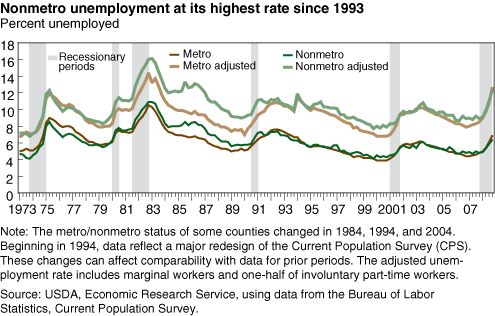Nonmetro Areas Showing the Effects of the Economic Downturns
- by Timothy Parker
- 6/1/2009
With the onset of the current recession in December 2007, the nonmetro unemployment rate jumped from 5.5 percent in the first quarter of 2008 to 8.5 percent a year later. This is the largest year-to-year point increase in the nonmetro unemployment rate since the beginning of the ERS data series in 1973. The metro unemployment rate increased from 5.2 percent to 8.9 percent in the same period.
An adjusted unemployment rate, computed by ERS, provides a more comprehensive measure that takes into account unemployed as well as underemployed and marginal workers (including discouraged workers). The nonmetro adjusted unemployment rate increased from 10.3 percent to 15.8 percent between the first quarters of 2008 and 2009. This was the highest adjusted unemployment rate since the first quarter of 1983, when it was 17.4 percent.
A large increase in the number of involuntary part-time workers accounted for part of the rise in the nonmetro adjusted unemployment rate in the first quarter of 2009. Involuntary part-time workers are those who want full-time work but work less than 35 hours a week due to slack economic conditions or the inability to find full-time work. Employers will often cut back on employees’ hours before resorting to layoffs. Between the first quarters of 2008 and 2009, the number of nonmetro involuntary part-time workers increased 58.8 percent, to 1,4 million workers.
Also contributing to the jump in the adjusted unemployment rate was a rise in the number of marginally attached workers—those who are not currently working or looking for work but who would work if a job were available. There was a 20.1-percent increase in marginal workers between the first quarters of 2008 and 2009.
Changes in the unemployment rate reflect whether businesses anticipate the economy will get better or worse. Often, businesses will not begin hiring until there is a clear indication that the economy is improving. Consequently, nonmetro unemployment is likely to continue to rise for some time, even if there is a quick upturn in the economy. In the last two recessions in 1990-91 and 2001, the national unemployment rate peaked approximately six quarters after the recessions had officially ended. For example, nonmetro unemployment did not peak until the third quarter of 2003—seven quarters after the 2001 recession had ended.
This article is drawn from:
- State Fact Sheets - State Data. (n.d.). U.S. Department of Agriculture, Economic Research Service.
- Employment & Education - Rural Education. (n.d.). U.S. Department of Agriculture, Economic Research Service.
You may also like:
- Parker, T. (2009, June 1). On The Map: Unemployment Rate Highest in Michigan. Amber Waves, U.S. Department of Agriculture, Economic Research Service.


